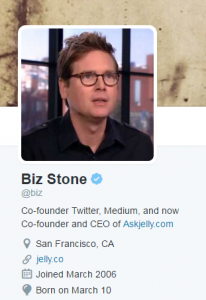 You may or may not have heard of Medium by now, but its slow and steady rise to popularity tells us that it has the potential for longevity. That’s saying a lot when you’re talking about social media, a dynamic environment that seems to change by the minute. Only time will tell how things will go for Medium, but for now, we’re saying it’s worth learning about. So, let’s dive right in.
You may or may not have heard of Medium by now, but its slow and steady rise to popularity tells us that it has the potential for longevity. That’s saying a lot when you’re talking about social media, a dynamic environment that seems to change by the minute. Only time will tell how things will go for Medium, but for now, we’re saying it’s worth learning about. So, let’s dive right in.
A Bit of History for You
Contrary to some of the buzz that we’ve heard circulating amongst our peers in the marketing industry, nothing about Medium is new. It was founded and launched in 2012 by none other than the notorious Biz Stone himself. You may have heard of him; he co-founded Twitter.
In fact, the very purpose of Medium was to solve that little 140-character conundrum. If you currently have or plan to create an account in Medium, you’ll noticed similarities between the feel and functionality of this and Twitter.
Becoming a Part of the Community
If you want to join Medium, you can open an account with your email address, Twitter, Facebook, or Google account. We used an email address, which did not immediately create our Medium account. Instead, it sent a link to the address we provided. If you go this route, you won’t be able to proceed until you have clicked the link, and it’s only good for 15 minutes, so be ready to access that right away.
 Once you have created your account, you will be asked to choose your favorite topics from a list. For the iDevice users in our audience, this looks remarkably similar to what you see in Apple News on your phone or iPad.
Once you have created your account, you will be asked to choose your favorite topics from a list. For the iDevice users in our audience, this looks remarkably similar to what you see in Apple News on your phone or iPad.
The entire process takes less than 5 minutes, and once it’s complete, your feed is curated instantly. You’re in business, and now you’re ready to write to your heart’s content.
For a step-by-step guide to optimizing your profile beyond these first steps, check out this helpful guide brought to you by Social Media Examiner.
What to Expect: A Series of Comparisons
The nature of Medium is yet to be determined. It’s a hybrid, to be sure, but whether you choose to think of it as a standard social media outlet or something else is entirely subjective. Medium has full WYSIWYG capabilities, which is a techie term for “What You See is What You Get”. This is similar to your WordPress visual editor, which caused many bloggers to initially question whether or not Medium was meant to compete with the likes of the more popular content management systems.
As a digitally-savvy business owner who is committed to growing your online presence, it’s safe to assume that you will recognize just about every feature of Medium. If you’re an active Redditor, you’ll appreciate the system of “upvoting” or “downvoting” posts to determine popularity. In contrast to Blogger, posts on Medium are sorted according to content themes (rather than by the name of the author). This is an extremely useful feature for marketers who know their target audience well. You can easily tailor your content to suit the likes and dislikes of your chosen demographic.
 Perhaps the most well-founded comparison of all, though, is the one made between this and Tumblr. Both can be considered platforms for social journalism that may be either a perfect fit or a total nightmare, depending on the nature of your business. While they have similar features, though, it’s important to note that Tumblr is more of a place for millennials and visually-driven businesses (art, real estate, publishing, etc). If you’re looking for a mature version of the same concept, Medium is it. You’ll find the same features and superior levels of engagement, but geared toward a more serious, business-minded crowd.
Perhaps the most well-founded comparison of all, though, is the one made between this and Tumblr. Both can be considered platforms for social journalism that may be either a perfect fit or a total nightmare, depending on the nature of your business. While they have similar features, though, it’s important to note that Tumblr is more of a place for millennials and visually-driven businesses (art, real estate, publishing, etc). If you’re looking for a mature version of the same concept, Medium is it. You’ll find the same features and superior levels of engagement, but geared toward a more serious, business-minded crowd.
Web marketing needs vary according to so many factors; determining the best platforms for telling your brand’s story can be complex and challenging. If you’re on the fence about using Medium or any other digital media for your business, contact a member of our team for a consultation.
